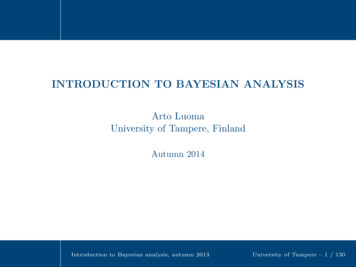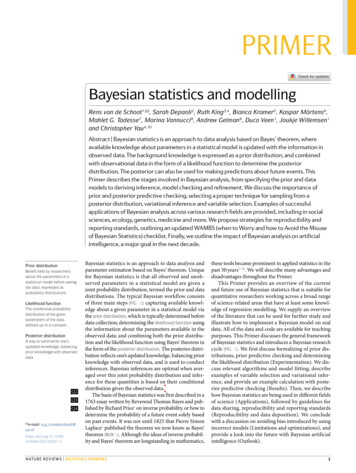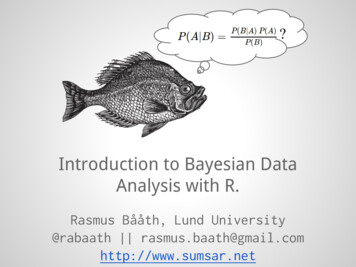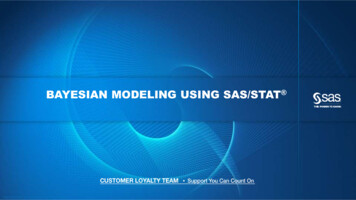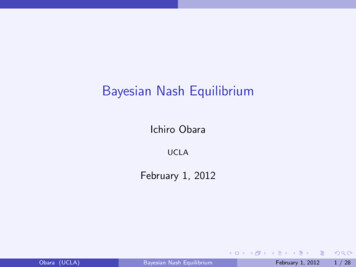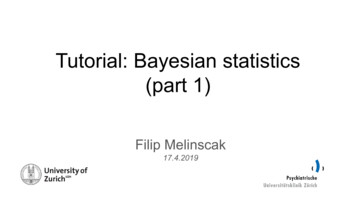
Transcription
Tutorial: Bayesian statistics(part 1)Filip Melinscak17.4.2019
OutlineWe will use the bottom-up approach, starting from principles, and ending onpractical applications. Why we need statistics?Which statistics we need? Frequentist and Bayesian interpretation of probabilityCommon misconceptions about frequentist statisticsArgument against frequentist and in favor of Bayesian statisticsBayesian inference Conceptual foundation: probability theoryBayes’ rule in the discrete caseBayes’ rule in the continuous case (parameter estimation)Bayesian model selection
Why we need statistics?
Sensemaking processReproduced from [Gro14]Why is this insufficient for quantitative data analysis?Why do we need statistics?
From sensemaking to data analysis (statistics)Reproduced from [Gro14]
From statistics to scientific inquiryReproduced from [Box76]
Role of statistics in science To borrow from John Maynard Keynes:“The ideas of economists statisticians and political philosophers philosophersof science, both when they are right and when they are wrong, are morepowerful than is commonly understood. [.] Practical men, who believethemselves to be quite exempt from any intellectual influence statisticalphilosophy, are usually the slaves of some defunct economist methodologist.” Statistics as the “grammar of science”:“The unity of all science consists alone in its method,not in its material.” - Karl Pearson Distinct roles of applied statistics and applied mathematics (cf. therelationship of chemistry and cooking)
“Role of statistics in science” The misconceptions aboutthe role of statistics: Reproduced from [McE18]Provides objective rules foranalyzing dataAllows us to determine the truthof scientific claimsThis “decision tree” view ofstatistics obscures the unityof all statistics and makes itmore difficult to learn;inherently inflexible
How does statistical philosophy influence our work? IMO, your statistical philosophy (knowingly or not) largely influences all partsof your scientific workflow: Types of theories and questions you test (if you only know NHST, you willonly ask questions that can be answered by NHST) Experimental design Data analyses and model checking Interpretation of results (both yours and from literature) Scientific communication (data and model visualization, framing ofresults)Bayesian inference provides you with a principled way of thinking of all thecomponents above
Which statistics we need?
Two interpretations of probability Probability theory: mathematical rules for manipulating probabilitiesProbability theory largely uncontroversial, but its correspondence to the realworld is; two interpretations of probability: Aleatory/frequentist probability: expected frequency over many repetitions of a procedureEpistemic/Bayesian probability: degree of belief agent should assign to event or proposition(inherently dependent on the agent’s state of knowledge)Why this matters? Aleatory probability does not apply to singular events or propositions (e.g. this hypothesis istrue, this effect exists)Epistemic probability applies both to singular and repetitive eventsCorrect interpretation of probability statements is crucial for making sound inferences
Testing our intuitions about p-valuesSuppose you have a treatment that you suspect may alter performance on a certain task. You comparethe means of your control and experimental groups (say 20 subjects in each sample). Further, supposeyou use a simple independent means t-test and your result is (t 2.7, d.f. 38, p 0.01). Please markeach of the statements below as “true” or “false”. “False” means that the statement does not followlogically from the above premises. Also note that several or none of the statements may be correct.Reproduced from [Gig04]
Testing our intuitions aboutconfidence intervalsReproduced from [Hoe14]
Testing our intuitions about frequentist results If you endorsed any of the previous statements, the good news is that youare in good company!Reproduced from [Gig04] Reproduced from [Hoe14]The bad news is that none of the statements are correct!
Reminder on p-valuesReproduced from [Kru18]User:Repapetilto @ Wikipedia & User:Chen-Pan Liao @ P-value in statistical significance testing.svg), „P-value in statistical significance testing“, sa/3.0/legalcode
Argument for Bayesian statisticsThe philosophical argument in favor of Bayesian statistics is straightforward[Lin00]:1.2.3.4.5.Statistics is the study of uncertaintyUncertainty should be measured by probabilities, which are manipulatedusing probability calculus (sum and product rules)Probabilities can be used to describe the uncertainty of dataProbabilities can also be used to describe the uncertainty of (hidden)parametersStatistical inference should be performed according to the rules of probabilitycalculus (i.e. the Bayes’ rule)
Advantages of Bayesian inference Reproduced from [Wag18]Common misconception:Bayesian inference ismodern/advanced/difficult tounderstand, whereas frequentistinference is established/easy(Bayesian computation can bedifficult, but there is software tohelp here)IMO, framing problems inBayesian terms is conceptuallysimple, and the interpretation ofresults is straightforward
Bayesian inference
Foundation of Bayesian inference: probability theory We need only a few rules from probability theory: Product (multiplication/chain) rule: what is the probability of A and B? Sum (addition) rule: what is the probability of A or B, if A and B are mutually exclusive? Total probability rule / “extending the conversation”: assume we have a disjoint set {A1,A2, . AK} (set of mutually exclusive events, of which one is true, e.g. {A, not A}), we canexpress of probability of B as a sum of joint probabilities with Ak eventsproduct rule
Conditioning on data (discrete case) Assume we are interested in the credibility of some hypothesis/model ‘M’ (andits negation ‘not M’), after observing data XFurther, assume we know the probability of the data given M and notM(P(X M) and P(X notM), and the probability of M and notM before observingthe data (P(M), P(notM))Given: Desired: We will now derive the Bayes’ rule, which will tell us how to go from the priorP(M) to the posterior P(M X)
Bayes’ rule in the discrete case (1) Let’s write the product rule for X and M:By symmetry, it is also true:We can equate right-hand sides:Finally, we rearrange so that we have what we want on LHS: Rejoice, this is the Bayes’ rule! But how do we compute the prior predictiveprobability of the data P(X)?
Bayes’ rule in the discrete case (2) We can use the total probability rule (“extend the conversation”) to get P(X): Finally, we can reformulate Bayes’ rule in terms of probabilities we know: For more than two hypotheses:
Example: Bayes’ rule for a truth-detecting-machine Imagine we have a machine that magically detects the truth of hypotheses weinput: when the hypothesis is true, the machine is 80% accurate, when thehypothesis is false, the machine is 95% accurateMoreover, imagine that we are not very good at coming up with hypothesesthat are actually true: only 10% of the time we input true hypothesesIf we input a hypothesis, and we get a “TRUTH” reading from the machine,what is the probability that the hypothesis is actually true?
Example: Bayes’ rule for a truth-detecting-machine Given: We apply the Bayes’ theorem:After applying ourtruth-telling-machine we are only64% sure of the truth of ourhypothesis!
Example: Bayes’ rule for a truth-detecting-machine What is the relative belief (i.e. posterior odds) of H vs. notHafter observing T?
Bayes’ rule in the continuous case (1) We go fromprobabilities toprobability densityfunctions (PDFs)By definition:Reproduced from [Etz18]
Bayes’ rule in the continuous case (2) To derive Bayes’ rule, we first need the continuous product rule: And the continuous total probability rule (i.e. marginalization, whenreading right to left): Bayes’ rule is then:
Bayes’ rule for parameter estimation Suppose we observed some data x produced by a stochastic process we aremodeling as p(x 𝜃), where 𝜃 represents parameters of the process (e.g. p(x 𝜃) N(x; 𝜇, 𝜎), where 𝜇 and 𝜎 are the parameters)How can we calculate the credibility of parameter values given the data(i.e. p(𝜃 x)? The answer is again Bayes’ nMarginallikelihood The denominator usually does not have an analytic solution, so we have touse approximations
Example: Bayesian parameter estimation ofCS /CS- difference with JASP JASP is a free, open-source alternative to SPSS that supports both classicaland Bayesian analysesWe will analyze the SCR CS /CS- difference for 21 subjects using theBayesian one sample t-testWe used the Cauchy prior with the default scale parameter of 0.707.
Bayesian model selection If we have two or more models under consideration we can do two types ofinference: continuous within-model (parameter estimation), and discretebetween-model (model selection) inferenceParameter selection can be done independently for each model: Models can be compared using posterior odds and Bayes factors:Posterior oddsPrior oddsBayes factor
Example: hypothesis testing of CS /CS- difference Again we use JASP with the same data as before; but now we do not want toalso compare the model of no effect existing vs. a model predicting the effectexistsReproduced from [vDo19]
Example: hypothesis testing of CS /CS- difference How do our conclusions depend on the prior? We can answer using arobustness (or sensitivity) check
Example: hypothesis testing of CS /CS- difference We could also collect data until we reach a certain level of certainty
Going further Most of the presentation was based on the paper of Etz & Vandekerckhove(2018), but the paper has a slower pace and goes into more detailsThe recent special issue of Psychonomic Bulletin & Review on Bayesianmethods features many excellent papers: http://bit.ly/BayesInPsychFor a slightly different approach, check Richard McElreath’s “StatisticalRethinking” course: https://github.com/rmcelreath/statrethinking winter2019
References[Box76] Box, G. E. (1976). Science and statistics. Journal of the American Statistical Association, 71(356), 791-799.[Etz18] Etz, A., & Vandekerckhove, J. (2018). Introduction to Bayesian inference for psychology. Psychonomic Bulletin & Review, 25(1), 5-34.[Gig04] Gigerenzer, G. (2004). Mindless statistics. The Journal of Socio-Economics, 33(5), 587-606.[Gro14] Grolemund, Garrett, and Hadley Wickham. "A cognitive interpretation of data analysis." International Statistical Review 82.2 (2014): 184-204.[Hoe14] Hoekstra, R., Morey, R. D., Rouder, J. N., & Wagenmakers, E.-J. (2014). Robust misinterpretation of confidence intervals. PsychonomicBulletin & Review, 21(5), 1157–1164.[Kru18] Kruschke, J. K., & Liddell, T. M. (2018). The Bayesian New Statistics: Hypothesis testing, estimation, meta-analysis, and power analysis froma Bayesian perspective. Psychonomic Bulletin & Review, 25(1), 178-206.[Lin00] Lindley, Dennis V. "The philosophy of statistics." Journal of the Royal Statistical Society: Series D (The Statistician) 49.3 (2000): 293-337.[McE18] McElreath, R. (2018). Statistical rethinking: A Bayesian course with examples in R and Stan. Chapman and Hall/CRC.[vDo19] van Doorn, J., van den Bergh, D., Bohm, U., Dablander, F., Derks, K., Draws, T., . & Ly, A. (2019). The JASP Guidelines for Conducting andReporting a Bayesian Analysis.[Wag18] Wagenmakers, E. J., Marsman, M., Jamil, T., Ly, A., Verhagen, J., Love, J., . & Matzke, D. (2018). Bayesian inference for psychology. PartI: Theoretical advantages and practical ramifications. Psychonomic bulletin & review, 25(1), 35-57.
JASP is a free, open-source alternative to SPSS that supports both classical and Bayesian analyses We will analyze the SCR CS /CS- difference for 21 subjects using the Bayesian one sample t-test We used the Cauchy prior with the default scale parameter of 0.707.
